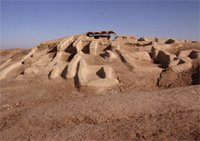New Architectural Style Discovered in Burnt City

Tehran, 21 January 2006 (CHN) -- A new architectural style was discovered during the archeological excavations in the residential area of Burnt City which had never been seen before in this historical site. This newly discovered style is somehow similar to the common architectural style of the mid-Islamic era.
The ninth season of excavations finished in the Burnet City, while during this season, in addition to the cemetery, the residential areas were excavated as well. Archeologists were faced with new architectural styles in this 5000-year-old historical site during this season of excavation.
“Archeological excavations in workshop no. 6, which is in the remains of a building, resulted in the discovery of a new architectural style in Burnt City, in which wood was used in different architectural layers,” said Mansour Sajadi, head of excavations team in Burnt City.
A 90-centimeter-wall has been discovered, on the surface of which some horizontal woods were used. Some mortar and mud were used in the construction of the wall to cover the wood chips,” explained Sajadi.
Prior to this, some 100-120 centimeter walls had been discovered in Burnt City
 's historical site. However, in none of them traces of wood chips were found. This is the first time such architectural style has been discovered in Burnt City historical site; nevertheless it is similar to architectural style of the mid-Islamic period. Such architectural style can also be seen in the construction of the Jame Mosque in Masouleh village in Gilan province, which was intended to strengthen the building against earthquakes.
's historical site. However, in none of them traces of wood chips were found. This is the first time such architectural style has been discovered in Burnt City historical site; nevertheless it is similar to architectural style of the mid-Islamic period. Such architectural style can also be seen in the construction of the Jame Mosque in Masouleh village in Gilan province, which was intended to strengthen the building against earthquakes.In this architectural style which has been abandoned since Safavid era, the woods used in the construction of the building prevent transforming of the earthquake vibrations to other layers of the wall and therefore save the construction from collapsing.
“We are still not sure about the reason for using this architectural style in Burnt City. If it was meant to strengthen the buildings against earthquake, this architectural style must have been used in other constructions of Burnt City as well, while such method has not even been seen in the Burnt City's castle. Moreover, the Italian archeological team, who had carried out a lot of excavations in this historical site, would have at least given some report in this respect if such architectural style had been observed before,” said Sajadi.
Burnt City (Shahr-e Sukhteh), located in Sistan va Baluchistan province in southeast of Iran, is a 5000 year old ancient site with historical graveyards and architectural structures. The city was once the habitat of a developed civilization with a rich culture and economy. Studies show that the site was once the center of international trade. The first archeological excavations at this site were carried out by the Italians, later on followed by the Iranians. The site has so far undergone 9 seasons of excavations, which have led to the discovery of some interesting artifacts such as the oldest backgammon of the world, the first animated feature of the world, and some edible seeds such as caraway, wheat, barley, grape, and garlic.

0 Comments:
Post a Comment
<< Home